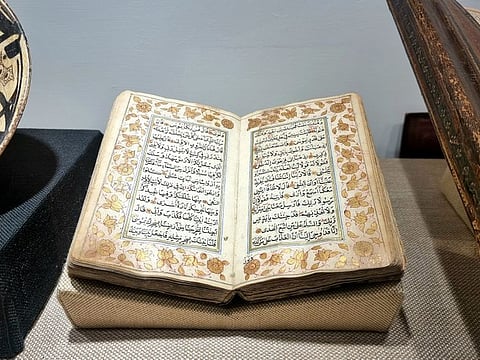Islamabad Museum reopens, displaying stolen artefacts returned to Pakistan
New extension of the museum will open new vistas for cultural heritage visitors

Islamabad: Islamabad Museum reopened this week after months of intense work, showcasing new artefacts of high historical value and allowing visitors to see Pakistan in a new light.
On display at the museum are 46 priceless smuggled artefacts that were recently returned to Pakistan by the United States government. The stolen artefacts finally returned home after months of negotiations, diplomacy, and legal proceedings required to obtain the return of the looted art.
In November 2022, the United States returned another 192 looted antiquities with a value of nearly $3.4 million to Pakistan after years-long investigation into the multi-million-dollar trafficking network.
Artefacts displayed for the first time
Among the recovered items exhibited at Islamabad Museum is the second-century Buddhist sculpture worth more than $1.1 million that was smuggled from Swat Valley in the 1980s.
“This ancient piece called Buddhapada depicts the footprint of the Buddha and is decorated with typical Gandharan art” the museum director Dr Abdul Ghafoor told Gulf News.
The unique feature of the Buddhapada, which is 116 centimetres wide and 90 centimetres tall, is its sacred symbols including the lotus flower, swastika (symbol of wellbeing), and dharmachakra (the Wheel of the Law), Triratna (three jewels) representing Buddha, his doctrine and his followers, he explained.
This ancient piece of Pakistan’s history and culture is now on display at the Islamabad Museum. Pakistan has one of the world’s biggest collections of Buddhist artefacts at Peshawar Museum.
Amir Muqam, the adviser to prime minister on national heritage and culture, inaugurated the renovated Islamabad Museum and praised the efforts of the Department of Archaeology and Museums (DOAM).
He said the recovered antiquities would add significant value to the museum and allow visitors to reconnect with the rich history of Pakistan. “This new extension of Islamabad Museum will open new vistas for cultural heritage visitors” he said.
Treasures on display
Islamabad Museum, currently housed in the Sir Syed Memorial building at Ataturk Avenue, is safeguarding the country’s artistic and cultural treasures. There are more than 760 artefacts including rare stone tool dating back to 2 million years, ceramics from 9,000 years old civilization, Gandhara period art, rare manuscripts from Mughal era. The museum’s collection offers a new light into the transformation of the stone age into an urban lifestyle in Pakistan.
“We are proud to have a complete chain of artefacts in a sequence that begin from 2 million years ago stone age. We have traces of old tools found in Khyber Pakhtunkhwa that are some 22,000 years old,” says Dr Abdul Ghafoor, an archeologist with over 26 years of experience.
Mehrgarh, located in Balochistan, was one of the earliest settlements ever discovered in South Asia that existed around 9,000 years ago, he continues. The Mehrgarh settlement that remained hidden for thousands of years was discovered by French and Pakistani archaeologists in 1974.
The museum also features artefacts from Indus Valley Civilization that goes back to almost 5,000 years around the time when the first pyramids were being built in Egypt. The Indus civilization is known as “the first planned city in the world” built with baked bricks, fascinating architecture, and elaborate drainage systems.
Rare displays
When asked which artefact he finds most fascinating, the Islamabad Museum director said “every artefact is culturally significant” but the most fascinating is the 2 million years old stone tool unearthed in Rawat near Islamabad. “This is one of the oldest such artefacts found after stone tool discovered in Kenya 3.3 million years ago” he said while giving a tour of the museum.
Some of the magnificent relics on display are 17-18 century Quran manuscripts with illumination in gold, 4,800-year-old pottery and terracotta figurines from Mehergarh, chert blades from Rohri Hills Sindh (between 10,000-3000 BC) and seals and stamps from Harappa from 3,000 BC. One of the displays that attract visitors is the Mughal miniature painting in ivory that depicts the crowded court of the last Mughal emperor Bahadur Shah Zafar in Diwan-e-Khas of Red Fort in Delhi.
Timeline of historical artefacts at Islamabad Museum
• Mehrgarh Civilization - 9,000 years old (7,000 to 2,500 BC) • Indus Valley Civilization - 5,000 years old (3,250 and 2,750 BC) • Gandhara Art - 1st century to 5th century CE • Islamic Period - 8th century to the Mughal period (16-18 centuries)
“Pakistan is one of the most ancient lands and has been home to many cultures and civilizations with the oldest traces from the Old Stone Age about two million years now. This journey over the two million years is an achievement that we have proudly displayed at the museum to pass on this ancient knowledge to our future generations” said Dr Ghafoor.
Pakistan has a rich and fascinating history but the heritage remains little known, partly discovered and less celebrated. Pakistani archaeologists are reviving efforts to excavate historic sites, and unearth the stories of the past and the mysteries of the lost civilizations. Archaeologists say they can do a lot better with funds and support from the government to “present the country’s glorious past to the world”.
Sign up for the Daily Briefing
Get the latest news and updates straight to your inbox



